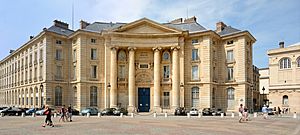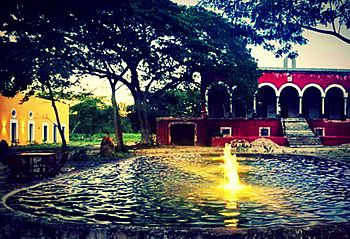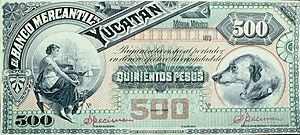Raymundo Cámara Luján facts for kids
Quick facts for kids
Raymundo Cámara Luján
|
|
|---|---|
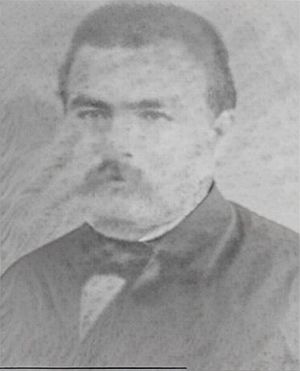 |
|
| Born | May 14, 1850 Mérida, Yucatán, Mexico
|
| Died | April 15, 1919 (aged 68) Mérida, Yucatán, Mexico
|
| Occupation |
|
| Spouse(s) | María del Carmen Vales Castillo |
| Children | 12, including Nicolás, Alfredo and María |
Raymundo Cámara Luján (born May 14, 1850 – died April 15, 1919) was an important Mexican businessman, banker, and landowner. He was also known for his kindness and giving to others. Raymundo played a big part in the economic growth of the Yucatán Peninsula in the late 1800s and early 1900s.
Cámara owned many large farms called haciendas. He was especially good at growing henequen (a plant used to make rope) and sugarcane. He started a company with José María Ponce Solís that became a top henequen seller. He also helped other businesses by giving them loans. His businesses included railways, banks, breweries, and collecting natural resources like chewing gum, tobacco, cocoa, cotton, bananas, and wood.
Raymundo Cámara was famous for treating his workers well. He was one of the first to set a minimum wage, an 8-hour workday, and allow workers to move between jobs. He also built schools in rural areas and supported workers forming unions. He believed in treating people with respect, which came from his Catholic faith. He also found that happy workers were more productive. Even though some people thought his changes cost too much, they really helped many workers in Yucatán. His children, Nicolás and Alfredo Cámara Vales, later became governors of Yucatán and Quintana Roo. His son-in-law, José María Pino Suárez, even became the Vice President of Mexico.
Contents
Early Life and Family
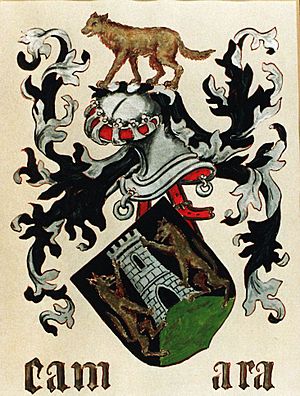
Raymundo was born on May 14, 1850, in Mérida, Yucatán, Mexico. Just five days later, he was baptized at the main church in Mérida. The ceremony was led by the Archbishop of Yucatán, and the Governor of Yucatán was a witness.
He was the first child of Nicolás de la Cámara y Castillo (a well-known landowner) and Evarista Luján Domínguez. His father's family, the Cámara family, was very old and respected. They had been important in Spain since the 1200s. One of their ancestors, Juan de la Cámara, came to Yucatán in 1539 and helped with the Spanish conquest of the area. Since then, the Cámara family became one of the biggest landowners in the Yucatán Peninsula. Raymundo's mother's family, the Luján family, was also well-known in Spain.
Raymundo's Education
Raymundo went to school in Paris, France, at a famous school called Lycée Louis-le-Grand. There, he earned a science degree. He then studied engineering at a top school called École Polytechnique. He also earned a law degree from the Faculty of Law of Paris (part of La Sorbonne).
He continued his studies in agricultural engineering at the Royal Agricultural College in Cirencester, England. This helped him later with his farming businesses.
Business Ventures
Henequen and Sugarcane Farms
Raymundo Cámara owned several large farms in Temax. Two of his most important farms were San Antonio Cámara and Chucmichén. Together, these farms covered 7,812 hectares (about 30 square miles), which is roughly the size of the island of Guernsey. These farms were mainly used to grow henequen.
In 1887, he teamed up with the Villamil Vales family to create a company called Compañía Particular de Fomento de Fincas, S.A. Their goal was to grow and sell henequen. They bought several other haciendas for this purpose.
Cámara also owned Hacienda de Tekik, another henequen farm.
His farming work wasn't just about henequen. He also owned several sugar mills that produced sugarcane. He was the second-largest sugarcane producer in the Yucatán Peninsula.
One of his important sugar mills was the Hacienda de Dziuché in Hoctún. This mill produced about 12,000 kilograms (26,455 pounds) of sugar and 10,000 kilograms (22,046 pounds) of honey each year.
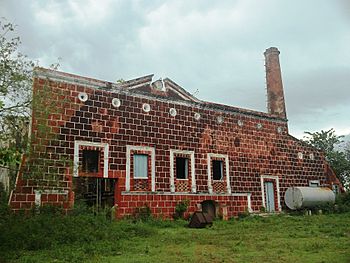
He also owned Hacienda Polyuc, a sugar mill in Tekax. From 1906 to 1909, his son-in-law, José María Pino Suárez, managed this hacienda. At Polyuc, Pino Suárez started a school that offered free education to workers. He also allowed workers to find jobs at other haciendas if they wished.
Raymundo Cámara also owned Hacienda Yokat in Ticul with other partners. This farm raised cattle and produced sugar and henequen.
After a big economic crisis in 1907, the Haciendas of Yokat and Polyuc were sold.
Cámara also co-owned a very large property (2,627 square kilometers or about 1,014 square miles) called Hacienda Santa María in Quintana Roo. This property was roughly the size of Luxembourg.
Influenced by his son-in-law, José María Pino Suárez, Raymundo Cámara brought in new, fair ways of treating his workers. He set a minimum wage and an 8-hour workday. He also made sure workers could move to other jobs and negotiate their working conditions. He believed in education, so he built schools on his farms to teach workers and their families how to read and write. Hacienda de Dziuché was one of the first places to have workers' unions, which inspired other landowners in Yucatán. Cámara's ideas came from his strong Catholic faith and his belief in treating workers with respect. He also saw that better conditions made workers more productive and increased profits. Even though some people criticized his changes as being too expensive, they greatly improved the lives of thousands of workers in Yucatán.
Ponce Trading Company
Cámara teamed up with his brother-in-law, José María Ponce Solís, to start a company called José Ma. Ponce y Cía. This company became one of the main exporters of henequen in the late 1800s. For example, in 1898, they exported about 16% of all the henequen fiber, which was around 13 million kilograms (28.6 million pounds) each year, mostly to the United States.
Besides exporting henequen, the company also acted like a bank. It gave loans to henequen farmers and other business owners. They even helped pay for the construction of a railway between Mérida and Valladolid. This railway was very important for moving henequen from the farms to the shipping ports.
However, by 1904, the company stopped operating. This happened partly because of changes in government leadership and new business agreements. A large American company, International Harvester, started to control most of the henequen market. This made it harder for smaller companies like Ponce y Cía. to compete.
Even though they reduced their involvement in henequen, Raymundo Cámara and José María Ponce Solís started to invest in other areas. In 1900, they opened Cervecería Yucateca, S.A., a brewery, as part of their new business plans.
The Cuyo Agricultural Company
Cámara also worked closely with Eusebio Escalante in business.
Together with Escalante and other business people, Cámara founded the Compañía Agrícola del Cuyo y Anexas, S.A. (The Cuyo Agricultural Company). He owned about one-fifth of this company. This company had over 1,500 workers and controlled a huge area of 2,627 square kilometers (about 1,014 square miles) in northwest Yucatán. This land was rich in wood for dyes, and good for growing sugarcane, vanilla, tobacco, corn, and other crops. They also collected sea salt and extracted tree resins (like chicle, used for chewing gum).
The company exported dye wood to Europe and chicle to New York. They sold about 400,000 kg (881,849 pounds) of chicle each year.
The Mercantile Bank of Yucatán
In 1890, the Mercantile Bank of Yucatán, S.A., was started. It was the first bank in the region. Raymundo Cámara was one of its founders and served on its first board of directors. This bank was closely connected to the businesses of the Escalante and Cámara families. However, it faced strong competition from another bank, the Yucatecan Bank, S.A.
During a big worldwide economic crisis in 1907, both banks faced difficulties. They were eventually combined to form the Banco Peninsular Mexicano, S.A. (which is now part of Banamex).
Family Life
On June 20, 1874, Raymundo married María del Carmen Vales Castillo. She was the daughter of Agustín Vales, a well-known banker and landowner.
Raymundo and María del Carmen had fourteen children, but twelve survived: Nicolás, María, Feliciana, Alfredo, Hortensia, María del Carmen, María Lucrecia, Raymundo, Leonor, Hernán, Jorge, and Elía.
His sons, Nicolás and Alfredo Cámara Vales, became important politicians. They both served as governors, Nicolás in Yucatán and Alfredo in Quintana Roo.
His eldest daughter, María, was honored in 1969 with the Belisario Domínguez Medal of Honor, a very important award in Mexico. She married José María Pino Suárez, who was the Vice President of Mexico from 1911 to 1913. Their son, Alfredo Pino Cámara, became a judge on the Supreme Court. Their grandson, Ismael Moreno Pino, was a lawyer and diplomat who helped create the Treaty of Tlatelolco, which banned nuclear weapons in Latin America and the Caribbean.
His daughter Hortensia married Pablo Castellanos León, a famous pianist. Their son, Pablo Castellanos Cámara, also became a distinguished pianist.
His son Hernán married Jacinta Barbachano Bolio. Their son, Fernando Cámara Barbachano, became a respected social anthropologist and museologist, working with the National Institute of Anthropology and History.
See also
 In Spanish: Raymundo Cámara Luján para niños
In Spanish: Raymundo Cámara Luján para niños


